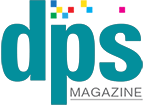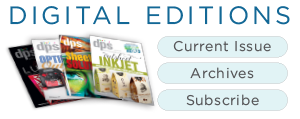by DPS Magazine Staff
The October issue of DPS Magazine looks at the evolving role digital print and finishing in folding carton production. Both B1—27.8×39.4 inches—and B2—19.7×27.8—sized digital presses are available for the production of folding cartons.
Matt Brooks, head of packaging, Digital Printing Solutions, Agfa, sees a strong pull in packaging, however, he notes that multiple applications across all segments are looking for a B1 solution, one that can fit into existing workflows and finishing lines that complements existing technologies.
“From an end product perspective, the vast majority of packages can be produced in a B1 workflow, which fits Landa’s B1 format digital press,” shares Amir Shalev, market development director, Landa Digital Printing. “One of the biggest reasons why Landa is embraced by folding carton producers is the fact that it can accommodate their existing B1 offset assets—and often enhance them with digital applications, as well.”
Shalev comments that B2 may be used for prototyping and very short runs, and more generally in cases where the package size fits.
Shahar Lev-Ari , product marketing manager, HP Indigo Folding Cartons, says B2 sized presses are ideal for digital born, short sized production runs and offer a balance between volume and customization.
B2 presses are are widely adopted in the luxury goods sector, where high-quality, visually appealing packaging is crucial. “Additionally, the cosmetics industry leverages B2 presses for their ability to produce intricate designs and vibrant colors that stand out on retail shelves,” says Lev-Ari.
Folding Carton Presses
Agfa’s SpeedSet Orca 1060 offers a dedicated digital solution for folding carton, paper, and microflute corrugated with up to seven color capability and a digitally printed primer and overprint varnish. “This is the world’s first and only fully digital water-based solution with mainstream production capabilities across multiple applications,” says Brooks.
The HP Indigo 35K Digital Press is designed for B2 sized carton production, offering unmatched versatility and print quality. This press delivers high productivity and superior color consistency using automated color matching.
HP’s growth strategy includes innovation, sustainability, and customer-centric approach. “Our commitment to innovation ensures that we remain at the forefront of digital printing technology, offering solutions that meet the evolving needs of our clients,” notes Lev-Ari.
Konica Minolta’s AccurioJet KM-1e with HD offers media flexibility with sizes of up to 585×750 millimeters (mm) B2-plus; sheet thickness of up to 0.6 mm in simplex and 0.45 mm in duplex printing; as well as print on offset coated and uncoated substrates, and even textured papers. The machine is able to produce a wide variety of jobs such as heavy textured stock and folding packaging.
The Landa S11 Nanographic Printing Press is the only field proven B1 single-sided sheetfed digital press. Designed for the production of mainstream folding cartons, the S11 delivers unmatched offset speed, quality, and stability. The Landa S11 Nanographic Printing Press integrates seamlessly into any digital or analog production floor and efficiently prints any job, digitally, with superior economics. The S11 runs spot colors with a color gamut covering 96 percent of the Pantone range, with best-in-class color consistency, regardless of print length.
It also supports substrates on a B1 format, with the ability to print on any paper or board without any pretreatment or priming and up to 800um thickness, and all while utilizing an industry standard, conventional inline coating unit—water-based and UV. The press runs variable data and brand protection applications as required by the world’s leading brands. The S11 is eco-friendly with no plates, near zero waste, water-based Landa Nanoink, and fully re-cyclable output.
The PrintAI module utilizes artificial intelligence to enhance print quality. It ensures a perfect fit for even the most demanding folding carton and commercial print applications—such as pharma, which require micro text and other brand protection features.
The 11K module employs a new ink drying system enabling transfer of dry ink from the blanket to the media at the speed of 11,200 sheets per hour. The high-speed capacity enables printing at offset speeds with the versatility of digital printing, allowing faster production with quicker turnaround times for urgent jobs, and all while improving production yield and economic benefits.
“Landa Digital Printing sees the folding carton packaging area as a tremendous opportunity—a large and growing market of which a growing portion requiring flexible and sustainable production remains under-served. Landa Digital Printing intends to further grow its footprint in this space while delivering value to its customers and consequently to consumers and the environment,” comments Shalev.
Xeikon offers the Cheetah CX50 and CX500 for folding carton production utilize dry toner technology. With a print quality that matches offset and flexography, and toners that are odorless and resistant to sunlight, water, and migration that is, safe for food. The CX50 reaches print speed of 65.6 feet per minute and a print width of 20 inches. The CX500 has a print speed of up to 98 fpm and width of 20 inches.
Market Segments
Many industries look to folding cartons packaging including food, pharmaceuticals, luxury brands, and cosmetics.
The healthcare segment is a key growth area. “Not only is the number of SKUs increasing; so is the need for highly flexible production that can accommodate new applications such as targeted medication and authentication,” says Shalev.
Growth in verticals where production agility is critical is also apparent, including personal care, electronics, and food and beverage. “There are also signs of a trend in in-plant production, where companies are choosing to insource their package production within their own facilities instead of using traditional converting companies,” shares Shalev.
Lev-Ari notes that pharmaceutical packaging often has a requirement for compliance, traceability, and personalization, which makes digital printing a natural fit for the pharmaceutical industry.
With an emphasis on aesthetics and customization, cosmetics relies on media diversity and multi-SKU per product. “Cosmetics brands are leveraging digital printing to create visually striking packaging that enhances brand identity,” says Lev-Ari.
The confectionery market benefits from digital printing’s ability to produce vibrant and playful packaging that appeals to consumers of all ages. “Digital print enables many campaigns to run with no inventory limitations as well as generate high engagement with the brand customers,” comments Lev-Ari.
Oct2024, DPS Magazine



